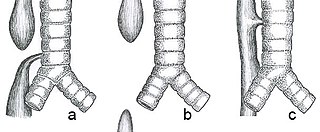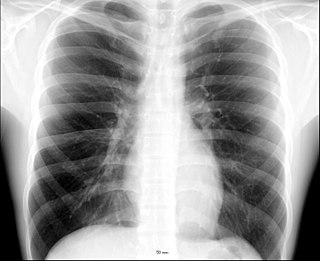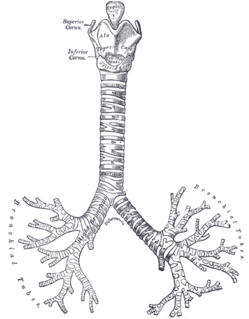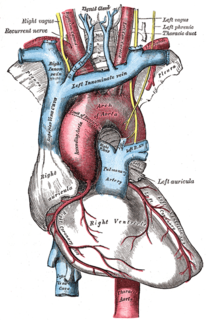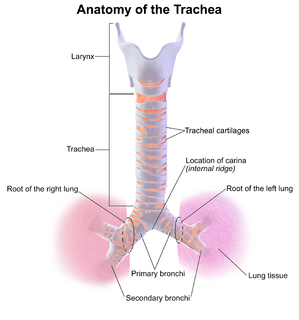

Tracheal collapse in dogs is a condition characterized by incomplete formation or weakening of the cartilaginous rings of the trachea resulting in flattening of the trachea. It can be congenital or acquired, and extrathoracic or intrathoracic (inside or outside the thoracic cavity). Tracheal collapse is a dynamic condition. Collapse of the cervical trachea or extrathoracic (in the neck) occurs during inspiration; collapse of the thoracic trachea or intrathoracic (in the chest) occurs during expiration. [1] Tracheal collapse is most commonly found in small dog breeds, including the Chihuahua, Pomeranian, Toy Poodle, Shih Tzu, Lhasa Apso, Maltese, Pug, and Yorkshire Terrier. [2]

Cartilage is a resilient and smooth elastic tissue, a rubber-like padding that covers and protects the ends of long bones at the joints, and is a structural component of the rib cage, the ear, the nose, the bronchial tubes, the intervertebral discs, and many other body components. It is not as hard and rigid as bone, but it is much stiffer and much less flexible than muscle. The matrix of cartilage is made up of glycosaminoglycans, proteoglycans,collagen fibers and, sometimes, elastin.

The domestic dog is a member of the genus Canis (canines), which forms part of the wolf-like canids, and is the most widely abundant terrestrial carnivore. The dog and the extant gray wolf are sister taxa as modern wolves are not closely related to the wolves that were first domesticated, which implies that the direct ancestor of the dog is extinct. The dog was the first species to be domesticated and has been selectively bred over millennia for various behaviors, sensory capabilities, and physical attributes.

The Chihuahua is the smallest breed of dog and is named after the state of Chihuahua in Mexico. Chihuahuas come in a wide variety of colors, and two coat lengths.
Congenital tracheal collapse appears to be caused by a deficiency of normal components of tracheal ring cartilage like glycosaminoglycans, glycoproteins, calcium, and chondroitin. Acquired tracheal collapse can be caused by Cushing's syndrome, heart disease, and chronic respiratory disease and infection. [3]

Glycosaminoglycans (GAGs) or mucopolysaccharides are long unbranched polysaccharides consisting of a repeating disaccharide unit. The repeating unit consists of an amino sugar along with a uronic sugar or galactose. Glycosaminoglycans are highly polar and attract water. They are therefore useful to the body as a lubricant or as a shock absorber.

Glycoproteins are proteins which contain oligosaccharide chains (glycans) covalently attached to amino acid side-chains. The carbohydrate is attached to the protein in a cotranslational or posttranslational modification. This process is known as glycosylation. Secreted extracellular proteins are often glycosylated.

Calcium is a chemical element with symbol Ca and atomic number 20. As an alkaline earth metal, calcium is a reactive metal that forms a dark oxide-nitride layer when exposed to air. Its physical and chemical properties are most similar to its heavier homologues strontium and barium. It is the fifth most abundant element in Earth's crust and the third most abundant metal, after iron and aluminium. The most common calcium compound on Earth is calcium carbonate, found in limestone and the fossilised remnants of early sea life; gypsum, anhydrite, fluorite, and apatite are also sources of calcium. The name derives from Latin calx "lime", which was obtained from heating limestone.
Symptoms include a cough (often called a "goose honk cough" due to its sound), especially when the dog is excited. This cough is usually paroxysmal in nature. Other symptoms include exercise intolerance, respiratory distress, and gagging while eating or drinking. Tracheal collapse is easily seen on a radiograph as a narrowing of the tracheal lumen. Treatment for mild to moderate cases include corticosteroids, bronchodilators, and antitussives. Medical treatment is successful in about 70 percent of tracheal collapse cases. [4] Severe cases can be treated with surgical implantation of a tracheal stent (inside or outside of the trachea) or prosthetic rings. Extraluminal (outside the trachea) stenting is generally used only for tracheal collapse in the neck region. Intraluminal stenting has shown more promise for success with intrathoracic cases, especially using nitinol, a type of shape memory alloy composed of nickel and titanium. Potential problems include stent migration and fracture. [5]

In biology, a lumen is the inside space of a tubular structure, such as an artery or intestine. It comes from Latin lumen, meaning 'an opening'.

Corticosteroids are a class of steroid hormones that are produced in the adrenal cortex of vertebrates, as well as the synthetic analogues of these hormones. Two main classes of corticosteroids, glucocorticoids and mineralocorticoids, are involved in a wide range of physiological processes, including stress response, immune response, and regulation of inflammation, carbohydrate metabolism, protein catabolism, blood electrolyte levels, and behavior.
A bronchodilator is a substance that dilates the bronchi and bronchioles, decreasing resistance in the respiratory airway and increasing airflow to the lungs. Bronchodilators may be endogenous, or they may be medications administered for the treatment of breathing difficulties. They are most useful in obstructive lung diseases, of which asthma and chronic obstructive pulmonary disease are the most common conditions. Although this remains somewhat controversial, they might be useful in bronchiolitis and bronchiectasis. They are often prescribed but of unproven significance in restrictive lung diseases.
Tracheal collapse has also been described in horses, both as a congenital condition and as a result of trauma. It is most commonly seen in the cervical trachea. [6]

The horse is one of two extant subspecies of Equus ferus. It is an odd-toed ungulate mammal belonging to the taxonomic family Equidae. The horse has evolved over the past 45 to 55 million years from a small multi-toed creature, Eohippus, into the large, single-toed animal of today. Humans began domesticating horses around 4000 BC, and their domestication is believed to have been widespread by 3000 BC. Horses in the subspecies caballus are domesticated, although some domesticated populations live in the wild as feral horses. These feral populations are not true wild horses, as this term is used to describe horses that have never been domesticated, such as the endangered Przewalski's horse, a separate subspecies, and the only remaining true wild horse. There is an extensive, specialized vocabulary used to describe equine-related concepts, covering everything from anatomy to life stages, size, colors, markings, breeds, locomotion, and behavior.

